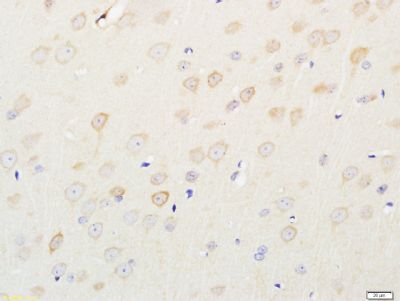
Phospho-FLG (Tyr766),磷酸化碱性成纤维细胞生长因子受体1抗体
产品名称: Phospho-FLG (Tyr766),磷酸化碱性成纤维细胞生长因子受体1抗体
英文名称: Anti-Phospho-FLG (Tyr766) antibody
产品编号: HZ-3136R
产品价格: null
产品产地: 中国/美国
品牌商标: HZbscience
更新时间: 2023-08-17T10:24:20
使用范围: WB,ELISA,IHC-P,IHC-F,IF
- 联系人 : 鲍丽雯
- 地址 : 上海市闵行区闵北路88弄1-30号第22幢AQ136室
- 邮编 : 200612
- 所在区域 : 上海
- 电话 : 139****0749 点击查看
- 传真 : 点击查看
- 邮箱 : www.shzbio.net
- 二维码 : 点击查看
Phospho-FLG (Tyr766),磷酸化碱性成纤维细胞生长因子受体1抗体
产品编号HZ-3136R
英文名称Phospho-FLG (Tyr766)
中文名称磷酸化碱性成纤维细胞生长因子受体1抗体
别 名FGFR1 (phospho Y766); p-FGFR1 (phospho Y766); Phospho-FGFR1 (Tyr766); P-FLG (Tyr766);FLG (Phospho-Tyr766);FGF Receptor 1; bFGF R; BFGFR; C FGR; CD 331; CD331; CD331 antigen; CEK; FGFBR; FGFR 1; FGFR1; Fibroblast growth factor receptor 1; FLG; FLG protein; FLJ14326; FLT 2; FLT2; Fms like tyrosine kinase 2; Fms related tyrosine kinase 2; Fms related tyrosine kinase 2 Pfeiffer syndrome; H2; H3; H4; H5; HBGFR; Heparin binding growth factor receptor; Hydroxyaryl protein kinase; KAL 2; KAL2; MFR; N SAM; N sam tyrosine kinase; Protein tyrosine kinase; Tyrosylprotein kinase; Basic fibroblast growth factor receptor 1.
说 明 书0.1ml
产品类型磷酸化抗体
研究领域肿瘤 免疫学 细胞凋亡 生长因子和激素 转录调节因子
抗体来源Rabbit
克隆类型Polyclonal
Phospho-FLG (Tyr766),磷酸化碱性成纤维细胞生长因子受体1抗体交叉反应 Human, Mouse, Rat, Chicken, Dog, Pig, Cow, Horse,
产品应用WB=1:100-500 ELISA=1:500-1000 IHC-P=1:100-500 IHC-F=1:100-500 IF=1:100-500 (石蜡切片需做抗原修复)
not yet tested in other applications.
optimal dilutions/concentrations should be determined by the end user.
分 子 量88kDa
细胞定位细胞膜
性 状Lyophilized or Liquid
浓 度1mg/1ml
免 疫 原KLH conjugated Synthesised phosphopeptide derived from human FGFR1 around the phosphorylation site of Tyr766
亚 型IgG
纯化方法affinity purified by Protein A
储 存 液0.01M TBS(pH7.4) with 1% BSA, 0.03% Proclin300 and 50% Glycerol.
保存条件Store at -20 °C for one year. Avoid repeated freeze/thaw cycles. The lyophilized antibody is stable at room temperature for at least one month and for greater than a year when kept at -20°C. When reconstituted in sterile pH 7.4 0.01M PBS or diluent of antibody the antibody is stable for at least two weeks at 2-4 °C.
Phospho-FLG (Tyr766),磷酸化碱性成纤维细胞生长因子受体1抗体PubMedPubMed
产品介绍background:
Fibroblast growth factors (FGFs) produce mitogenic and angiogenic effects in target cells by signaling through the cellular surface tyrosine kinase receptors. There are four members of the FGF receptor family: FGFR-1 (flg), FGFR-2 (bek, KGFR), FGFR-3 and FGFR-4. Each receptor contains an extracellular ligand binding domain, a transmembrane region and a cytoplasmic kinase domain (1). Following ligand binding and dimerization, the receptors are phosphorylated at specific tyrosine residues (2). Seven tyrosine residues in the cytoplasmic tail of FGFR-1 can be phosphorylated: Tyr463, Tyr583, Tyr585, Tyr653, Tyr654, Tyr730 and Tyr766. Tyrosine 653 and 654 are important for catalytic activity of the activated FGFR and are essential for signaling (3). The other phosphorylated tyrosine residues may provide docking sites for downstream signaling components such as Crk and PLCgamma.
Function:
Receptor for fibroblast growth factors FGF2 and FGF1. Receptor for FGF23 in the presence of KL (By similarity). Promotes mitogenesis in response to fibroblast growth factors. Activates PLCG1.
Subunit:
Homodimer. Interacts with KLB. Interacts with KL and FGF23. Interacts with SHB and GRB10. Interacts with PLCG1 (via SH2 domains). Interacts with KAL1; this interaction does not interfere with FGF2-binding to FGFR1, but prevents binding of heparin-bound FGF2. Interacts with SOX2 and SOX3.
Phospho-FLG (Tyr766),磷酸化碱性成纤维细胞生长因子受体1抗体Subcellular Location:
Membrane; Single-pass type I membrane protein.
Tissue Specificity:
Detected in astrocytoma, neuroblastoma and adrenal cortex cell lines. Some isoforms are detected in foreskin fibroblast cell lines, however isoform 17, isoform 18 and isoform 19 are not detected in these cells.
Post-translational modifications:
Binding of FGF1 and heparin promotes autophosphorylation on tyrosine residues and activation of the receptor.
DISEASE:
Defects in FGFR1 are a cause of Pfeiffer syndrome (PS) [MIM:101600]; also known as acrocephalosyndactyly type V (ACS5). PS is characterized by craniosynostosis (premature fusion of the skull sutures) with deviation and enlargement of the thumbs and great toes, brachymesophalangy, with phalangeal ankylosis and a varying degree of soft tissue syndactyly.
Defects in FGFR1 are a cause of idiopathic hypogonadotropic hypogonadism (IHH) [MIM:146110]. IHH is defined as a deficiency of the pituitary secretion of follicle-stimulating hormone and luteinizing hormone, which results in the impairment of pubertal maturation and of reproductive function.
Similarity:
Belongs to the protein kinase superfamily. Tyr protein kinase family. Fibroblast growth factor receptor subfamily.
Contains 3 Ig-like C2-type (immunoglobulin-like) domains.
Contains 1 protein kinase domain.
Gene ID:
2260
Phospho-FLG (Tyr766),磷酸化碱性成纤维细胞生长因子受体1抗体Database links:
Entrez Gene: 2260 Human
Entrez Gene: 14182 Mouse
Entrez Gene: 79114 Rat
Omim: 136350 Human
SwissProt: P11362 Human
SwissProt: P16092 Mouse
SwissProt: Q04589 Rat
Unigene: 264887 Human
Unigene: 265716 Mouse
Unigene: 207203 Rat
Unigene: 9797 Rat
Important Note:
This product as supplied is intended for research use only, not for use in human, therapeutic or diagnostic applications.

